Part One: The ADA’s Requirements for Small Towns
Title II of the ADA applies to State and local governments, including towns and townships, school districts, water districts, special purpose districts, and other small local governments and instrumentalities. It prohibits discrimination on the basis of disability in all services, programs, and activities provided by towns 1. Thus, people with disabilities must have an equal opportunity to participate in and benefit from a town’s services, programs, and activities. To accomplish this, the ADA sets requirements for town facilities, new construction and alterations, communications with the public, and policies and procedures governing town programs, services, and activities.
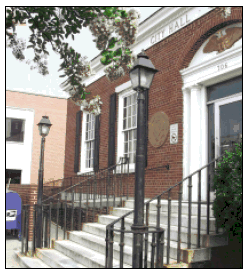
A ramp located next to the stairs to this town hall provides an accessible entrance.
1 The term "towns" is used in this publication to refer to all small local governments, towns, and townships. Please remember that title II applies to all State and local government entities, regardless of size, including State governments, local governments, special government entities such as transportation authorities, school districts, water districts, and other special purpose districts.
1. Existing Facilities: Program Accessibility.
When programs, services, or activities are located in facilities that existed prior to January 26, 1992, the effective date of title II of the ADA, towns must make sure that they are also available to persons with disabilities, unless to do so would fundamentally alter a program, service, or activity or result in undue financial or administrative burdens (see page 8). This requirement is called program accessibility. When a service, program, or activity is located in a building that is not accessible, a small town can achieve program accessibility in several ways. It can:
• relocate the program or activity to an accessible facility,
• provide the activity, service, or benefit in another manner that meets ADA requirements, or
• make modifications to the building or facility itself to provide accessibility. Thus, to achieve program accessibility, a small town need not make every existing facility accessible. It can relocate some programs to accessible facilities and modify other facilities, avoiding expensive physical modifications of all town facilities.
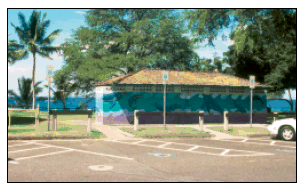
Physical modifications to provide program accessibility included parking spaces, the public toilet facility and an accessible route to the ocean overlook.
Example
A town holds its annual town meeting in an inaccessible location, the second floor of the two-story town hall that has no elevator. The town council considers installing an elevator in the building as well as replacing the existing town hall with a new, fully accessible building, but determines that the town’s limited financial resources will not allow either of these approaches. Instead, the town officials decide to hold the town meetings, as well as other public meetings where large numbers of the public are expected to attend, in the accessible auditorium of its local high school. The town officials also decide to move smaller meetings, which are periodically held on the second floor of the town hall, to the school auditorium, when they receive a request within 24 hours of a meeting.
Example
The town library is a historic structure that is listed on the State historic register. The two entrances to the facility each have four steps and no accessible entrance is provided. The town consults with an architect to determine if an accessible entrance can be provided and is told that a ramp or lift cannot be added to either entrance without a significant change to the exterior of the building. After reviewing the ADA requirements, the town learns that qualified historic buildings and facilities are not required to take any action that would threaten or destroy the historic significance of a historic property. The State historic preservation office is consulted and it determines that the exterior cannot be modified. Because physical modifications to the entrances cannot be made, the town changes its policies and provides access to the library services in an “alternate manner” upon request. Library staff are trained to take requests over the telephone, to look up information for individuals with disabilities who cannot use the library, to provide information over the telephone, and to provide curbside service for books and library publications or to mail items to individuals upon request. Library staff may also meet with an individual in another accessible location when the telephone service is not effective. The library publicizes a telephone number for requesting these alternate services in its publications and announcements.
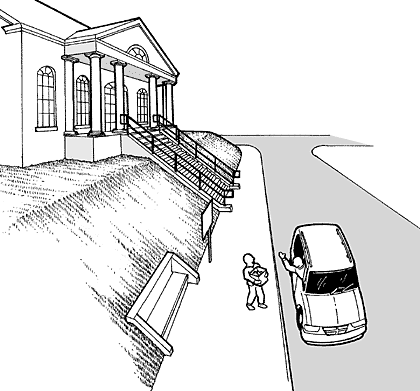
Library staff provide curbside services because the library facility cannot be made accessible.
Example
A town-operated two story historic house museum, which dates from 1885, provides exhibition and instructional programs for the public. The focus of the program is the exhibition of a typical 19th century Victorian house.
The self-evaluation determines that the house is not accessible. After considering the options for providing access to the programs and services, the town decides that it is not possible to move the museum programs to other accessible locations because the historic house itself is a critical part of the historic house program. The town develops plans to alter the facility to provide physical access to the first floor. These alterations are planned in compliance with the historic preservation requirements of the ADA Standards.
After reviewing the alterations with the State historic preservation office, the town determines that the second floor cannot be made accessible without threatening the unique features and historic significance of the house. Because the town must consider alternatives to structural changes in these instances, the town establishes a policy to locate all temporary programs on the first floor. In addition, the town documents the second floor spaces and content using video or other innovative solutions and provides an accessible viewing area on the first floor.
Example
The town's police station has one step at the public entrance and there is no accessible entrance available. After considering its options for providing program accessibility, the town decides to modify the facility to provide access rather than relocate the police programs or services. After review of the programs and services provided at the station, the town determines that the public entrance, lobby, and service counter need to be accessible to provide program accessibility. Therefore, alterations are limited to those items necessary to achieve program accessibility. In this case, it includes providing a van-accessible parking space in the parking lot, an accessible route from the parking space to the modified public entrance, and an accessible service counter inside the police station.
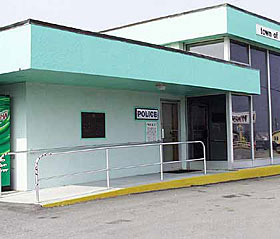
A town chose to alter its police station rather than move its programs and services to another accessible location.
When a town becomes aware that a program is not accessible and plans to alter a facility to provide access, it may be necessary to temporarily relocate a program, service, or activity to a temporary accessible location or to temporarily offer the service in an alternate manner.
This temporary solution assures that the service, program, or activity is accessible during the time the alterations are planned and being implemented.
Example
The public toilet facilities at the town recreation area are not accessible. After consideration of whether to modify the facilities or to relocate the programs held at the recreation area, the town decides to alter the toilet facilities and the walkway leading to them. While the fundraising is done, alterations planned, and the work completed, the town provides temporary portable toilet facilities that are accessible.
When choosing a method of providing program access, a public entity must give priority to the one that results in the most integrated setting appropriate to encourage interaction among all users, including individuals with disabilities. In addition, a town may offer additional activities or services so an individual with a disability can more fully participate in, or benefit from, a program, service, or activity. However, when such special activities or services are provided for people with disabilities, the town must permit a person with a disability to choose to participate in services, programs, or activities that are not different or separate.
Example
The local town pool provides a swimming program for people with disabilities that includes additional staff who provide individualized instruction. A person with a disability participates in the program. The person applies to attend group swimming lessons that are open to the public even though these lessons do not provide specialized instruction. The town must permit the individual with a disability to participate unless doing so would fundamentally alter the program
Because program accessibility may be provided in an accessible part of a facility when the remainder of the facility is not accessible, the public must be informed of the location of accessible features. Signs should direct the public to the location of accessible elements and spaces, including the location of accessible parking, the accessible entrance to a facility, and accessible toilet rooms. In addition, a town may issue a brochure or pamphlet with a map indicating the town's accessible features.
Example
A town hall has two sets of public toilet rooms. One set has been altered and is accessible, and the other set is not accessible. The town installs signage at the inaccessible toilet rooms directing people to the accessible toilet rooms.
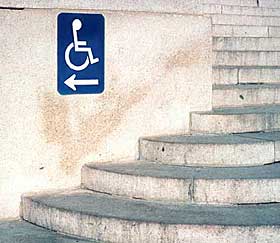
Sign at an inaccessible entrance provides directions to the nearest accessible entrance
Towns making modifications to a building or facility to provide program accessibility must comply with the ADA Standards for Accessible Design (ADA Standards) or the Uniform Federal Accessibility Standards (UFAS).
New Construction
ADA requirements for new construction have been in effect since January 1992. New buildings and facilities must comply with the new construction provisions of the ADA Standards for Accessible Design (without the elevator exemption) or the Uniform Federal Accessibility Standards (UFAS). This requirement includes facilities that are open to the public and those that are for use by employees.
The ADA Standards for Accessible Design (ADA Standards) were first issued in 1991 and have been selected as the ADA design standard by many towns. Although towns now have the option to choose either the ADA Standards or the UFAS, it is likely that in the future the ADA Standards will become the only design standard under the ADA. Because ADA requirements for new construction and alterations do change from time to time, towns should become familiar with any new design and construction requirements before a project starts (see Resources for free information sources).
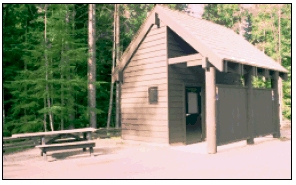
Public toilets at a park were built to comply with the new construction requirements of the ADA Standards.
Alterations and Additions
When a building or facility is renovated or altered or added to for any purpose, the alterations or additions must comply with the ADA Standards. In general, the alteration provisions are the same as the new construction requirements except that deviations are permitted when it is not technically feasible to comply. Additions are considered an alteration but the addition must follow the new construction requirements. When existing structural and other conditions make it impossible to meet all the alteration requirements of the ADA Standards, then they should be followed to the greatest extent possible.
Basic Requirements for Alterations:
• Any alteration that affects the usability of a building or facility must comply with the requirements of the ADA Standards unless technically infeasible to do so. Alterations can be as limited as the replacement of a fixture or element, such as a lavatory, toilet, or piece of door hardware.
• When an element is replaced, the new element must comply with the ADA Standards if the minimum requirements for accessibility under the ADA have not already been met.
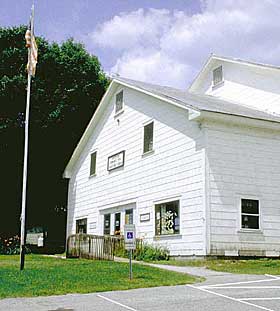
Alterations to existing town buildings follow the alteration requirements of the ADA Standards.
• When a town alters an area of a facility that contains a primary function area, the town has an additional obligation. The town is also responsible for making the path of travel to the altered area (room or wing), as well as the toilet rooms, drinking fountains, and public telephones serving the altered area accessible. Primary function areas are those areas of a building that include the primary spaces for which the building was constructed (for example, offices or meeting areas in a town hall, locker rooms in an athletic facility, or classrooms in a school or training center). The amount of money the town must spend to provide an accessible path of travel is limited to 20% of the overall cost of the alterations. If the path of travel alterations can be done for less than the 20% limit, then only that expenditure is required. If all the required accessible features are already provided then no additional expenditure is needed.
• When a qualified historic facility is altered, an exception to the alteration requirements of the ADA Standards may be used if the alteration threatens to destroy the historic significance of the building or facility. In these situations, special provisions in the Standards may be used for the element or space that would be threatened. In almost all situations, accessible design can be used without significantly impairing the historic features of the facility.
• The ADA Standards have specific requirements for additions. Additions, which include an expansion, extension or increase of the gross floor area of a building or facility, are considered an alteration to a facility but the area that is added must comply with the new construction requirements. Each addition that affects or could affect the usability of an area containing a primary function area must meet the path of travel requirements (see above).
3. Maintenance of Accessible Features.
Towns must maintain in operable working condition those features that are necessary to provide access to services, programs, and activities -- including elevators and lifts, curb ramps at intersections, accessible parking spaces, ramps to building or facility entrances, door hardware, and accessible toilet facilities. Isolated or temporary interruptions in service or access are permitted for maintenance or repairs.
Example
When weather conditions such as snow and ice limit or prevent access to services, programs, and activities, a town that houses programs in an accessible facility will have to maintain access to ensure that those programs are accessible. Maintenance of accessible features would include the removal of snow from accessible parking spaces, parking space access aisles, the accessible route to the accessible entrance, and accessible entrances. Although temporary interruptions in services due to bad weather are expected, alternate services should be provided if snow and ice cannot be cleared in a timely manner.
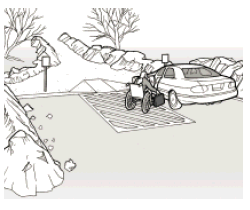
Clearing snow from accessible parking spaces and the accessible route may be essential to provide access to programs, services, or activities.
Example
A town building that was built before the ADA went into effect has a lift that provides access from inside the building to the library. The town must maintain the lift in working condition to assure that the public has access to the library programs. If the lift is out of order, repairs must be made in a timely fashion. Until the repairs are made, the town should provide alternate service for wheelchair users and others with disabilities who can no longer gain access to the library. These services may include retrieval of library materials by staff who will meet with an individual in an accessible location.
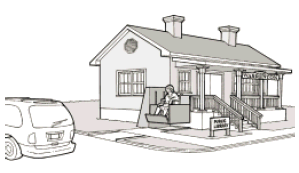
A lift provides access to the programs and services held in this town library. If the lift is out of service, alternate services are provided in an accessible location until the lift is repaired.
4. Effective Communication.
Towns must take appropriate steps to ensure that communications with members of the public, job applicants, and participants with disabilities are as effective as communications with others unless it is an undue financial or administrative burden to do so or it would result in a fundamental alteration (see page 8) in the nature of its program or activity.
Achieving effective communication often requires that towns provide auxiliary aids and services. Examples of auxiliary aids and services include qualified sign language interpreters, assistive listening devices, open and closed captioning, notetakers, written materials, telephone handset devices, qualified readers, taped texts, audio recordings, Brailled materials, materials on computer disk, and large print materials.
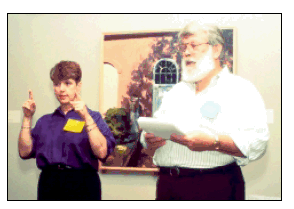
A sign language interpreter is one type of auxiliary aid or service that may be requested.
Towns must provide appropriate auxiliary aids and services where they are necessary to achieve an equal opportunity to participate in, and enjoy the benefits of, a service, program, or activity conducted by or for the town. The town must give primary consideration to the type of auxiliary aid requested by a person with a disability. However, the town may provide a different type of aid if it can show that it is an effective means of communication.
Example
A town prepares to hold its annual town meeting in the high school gymnasium. A request is made through the meeting coordinator for real time captioning to be provided for a person who is deaf. Real time captioning displays the spoken content from a meeting or a speech on a large television screen as text. The town gives primary consideration to the request but after discussing alternatives for providing effective communication with the individual who made the request, the town learns that the individual is fluent in American Sign Language (ASL). The town offers to provide a qualified ASL sign language interpreter for the town meeting because it has determined from discussions with the individual that the interpreter can provide effective communication.
Determination of an undue financial burden or a fundamental alteration can only be made by the head of the town government or his or her designee and must be accompanied by a written statement of the reasons for reaching that conclusion. The determination of an undue burden must be based on all resources available for use in the program, service, or activity. When it is not possible to provide a particular type of auxiliary aid to achieve effective communication due to an undue burden or fundamental alteration, the town must take any other action that would not result in such burdens or fundamental alteration, but would nevertheless ensure that individuals with disabilities receive the benefits and services of the program or activity.
If a town communicates with applicants and beneficiaries by telephone, it should ensure that an effective telecommunication system such as communication using the relay system or a TTY (or TDD) be used to communicate with individuals who are deaf, hard-of-hearing or who have speech disabilities. A TTY has a keyboard and visual display for non-verbal communication with another TTY user or a relay system operator. The relay system is provided in each State and permits telephone communication between voice handsets and individuals using a TTY.
A town can choose to provide a TTY without significant expense. Some towns have decided to install a portable TTY next to a public pay telephone and to anchor the portable unit to a shelf. Electrical connections are enclosed to protect against accidental disconnection of power.
Requirements for effective communications also apply to “telephone emergency services” that provide a basic emergency service, such as police, fire, and ambulance, that are provided by public safety agencies, including 9‒1‒1 (or, in some cases, seven-digit) systems. Direct, equal access must be provided to all services included in the system, including services such as emergency poison control information. Where direct access is provided to callers, direct access by TTY users means the telephone emergency service cannot use a relay system or transfer all TTY calls to one operator while other callers have access to all available operators (for more information, see the Department’s publication, Access for 9‒1‒1 and Telephone Emergency Services Under the Americans with Disabilities Act).
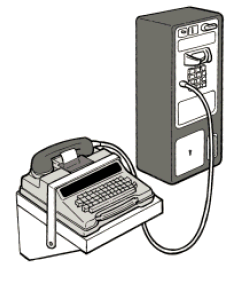
A portable TTY mounted on a shelf located next to a pay telephone can provide a low-cost TTY solution.
5. Policies, Practices, and Procedures.
Towns must make reasonable modifications to policies, practices, and procedures to avoid discrimination against individuals with disabilities. While this requirement applies to all policies, practices, and procedures of the town, the town does not have to make modifications that would result in a fundamental alteration in the program, service, or activity or result in a direct threat to the health or safety of others. A direct threat is a significant risk that cannot be eliminated or reduced to an acceptable level by the town’s modification of its policies, practices, or procedures, or by the provision of auxiliary aids or services. The public entity’s determination that a person poses a direct threat to the health or safety of others may not be based on generalizations or stereotypes about the effects of a particular disability (see The ADA Title II Technical Assistance Manual).
The self-evaluation typically includes a review of polices, practices, and procedures (see page 10, Processes for Complying with the ADA). Periodic review after the self-evaluation may be done to maintain compliance with the ADA. A town can choose how it wants to conduct a review of policies and practices that govern the administration of the town’s programs, activities, and services. Towns that have already done a self-evaluation do not have to do another one.
Review of policies, practices, and procedures also applies to telephone emergency services, such as 9‒1‒1, where policies must ensure direct access to individuals who use TTY’s and computer modems.
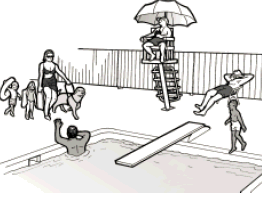
A mother with her service animal leads her children to the town pool. Policies and procedures that restrict or prohibit service animals may violate the ADA.
Example
A town pool requires that adults provide photo identification to verify residency before using the pool or participating in pool programs. During review of town policies, practices, and procedures, the town determines that the pool identification policy, which requires that a driver’s license with a photo be presented to gain admission, may discriminate against people with disabilities who may not have a driver’s license. The town changes its policy to permit other forms of identification to verify residency.
6. Processes for Complying with the ADA.
Towns that have not already conducted a self-evaluation or updated a previous self-evaluation conducted under Section 504 of the Rehabilitation Act must do so. The self-evaluation is a review of all town services, programs, and activities to identify any physical barriers or policies, practices, or procedures that may limit or exclude participation by people with disabilities. The self-evaluation includes permanent, temporary, and periodic services, programs, and activities. Each town should look at what services, programs, or activities are offered and in what location.
Any policies, practices, or procedures that may limit or exclude individuals with disabilities must be reasonably modified, unless doing so would result in a fundamental alteration in the nature of the service, program, or activity. The self-evaluation should identify changes to policies to be implemented. It should also identify any discriminatory policies, practices, and procedures that cannot be reasonably changed without resulting in a fundamental alteration.
The self-evaluation also identifies problems with the accessibility of facilities and establishes recommendations for providing program accessibility (which may include relocation to an accessible facility). It may also suggest short-term and long-term strategies to provide access to people with disabilities.
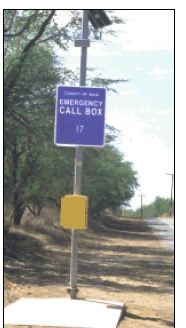
An emergency call box located in a rural area is mounted in an accessible location and can be used with or without speech to provide effective communication.
Towns that completed a self-evaluation to comply with section 504 of the Rehabilitation Act only have to bring the 504 self-evaluation up to date with ADA requirements by evaluating the services, programs, and activities that have changed. However, because considerable time has passed since most section 504 self-evaluations were done, it would be best to conduct a new self-evaluation.
Provide public notice about ADA requirements
A small town must provide notice to the public about its ADA obligations and about accessible facilities and services in the town. The notice must inform the public about the ADA’s nondiscrimination requirements. It may also describe how the public or employees may contact specific town officials about problems with accessibility and the need for effective communication. The information must be accessible to the public, including people who have disabilities that affect communication, such as blindness, low vision, deafness, and hearing loss. Although no specific method is required to reach the public, notice can be provided in more than one format and by using more than one type of media, such as the town’s website, print, radio, or television.
Other obligations for larger towns with 50 or more employees
Although the ADA only requires State and local governments with 50 or more employees to take the following measures, towns with less than fifty employees may want to consider following the same or similar steps because the process may make it easier to comply with the ADA.
a) Designate an individual to coordinate ADA compliance
Responsibilities for the ADA coordinator may include conducting the self-evaluation and developing the transition plan (see below), handling requests for auxiliary aids and services, providing information about accessible programs and services, and serving as a local resource to the town or township. The ADA coordinator may also have responsibility for working with the mayor or town council to ensure that new facilities or alterations to town facilities meet ADA requirements. In some communities, this individual also receives complaints from the public and works to resolve them.
b) Develop a transition plan
If a town with 50 or more employees decides to make physical changes to achieve program access it must develop a written plan that identifies the modifications that will be made. The plan should include timelines for completing these modifications. Interested parties, including people with disabilities and organizations representing people with disabilities, must at a minimum have an opportunity to participate in the development of the plan by submitting comments. A copy of the plan and a copy of the self-evaluation must be available for public inspection for three years after completion.
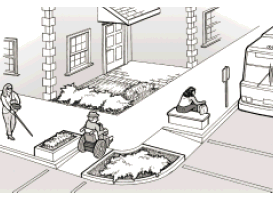
Installation of curb ramps is one of the items included in the transition plan. This type of curb ramp is used when some type of barrier prevents pedestrians from entering the curb ramp from the side.
c) Develop a grievance procedure
Towns with fifty or more employees must have an ADA grievance procedure. A grievance procedure provides people who feel they have been discriminated against because of their disability, or others who feel they have been discriminated against because they have a friend or family member with a disability, with a formal process to make their complaint known to the town. This procedure encourages prompt and equitable resolution of the problem at the local level without having to force individuals to file a Federal complaint or a lawsuit.

User Comments/Questions
Add Comment/Question